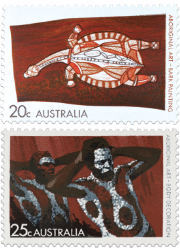History
Timeline results for
Found 1175 results for your search. Showing page 16 of 59.
1971
-
Aboriginal workers walk off the Noonkanbah cattle and sheep station in Western Australia to stop oil drilling on a sacred site.
-
Gumatj Elders Millrrpum and others take on Nabalco Pty Ltd and the federal government in the Gove land rights case following on from the Bark Petition. The Northern Territory Supreme Court ruled that Aboriginal people did not, under Australian law own the Arnhem Land reserve. This meant Nabalco could mine bauxite from the land.
-
Jack Charles and Bob Maza found the first Aboriginal theatre company Nindethana.
-
Larrakia people ‘sit-in’ at Bagot Road, Darwin as a protest against theft of their land.
-
Queensland Aborigines Act is passed, maintaining some legal restrictions for Aboriginal people living on reserves. Aboriginal cultural customs are banned and reading matter, mail, recreation, and marital and sexual relationships are censored. Their work and wage worth can be decreased and their movements recorded.
-
NSW Aboriginal Legal Service is formed, followed by Aboriginal pre-school, Black Theatre and the Aboriginal Housing Company.
-
Neville Bonner becomes the first Aboriginal Member of Parliament, filling a casual Senate vacancy. In 1972 he is elected on the Liberal Party ticket in Queensland. Senator Bonner continues to represent Queensland as a Liberal Senator until 1983.
-

The first issue showing Aboriginal art did not mention the artist but avoided culturally sensitive material. Australia Post releases the first stamp issue to focus on traditional, authentic Aboriginal art forms, titled "Aboriginal Art". While focusing on traditional arts forms, the stamps does not yet name the artist (which started with the 1988 issue).
The 20c design is based on a bark painting of a long necked tortoise from Western Arnhem Land; the 25c, was based on a photograph by Australian anthropologist, Sir Baldwin Spencer (see below); the 30c shows rock paintings of a cave in the Oenpelli area of Western Arnhem Land; the 35c depicts grave posts used in mourning ceremonies on Bathurst & Melville Islands.
The 25 cent stamp shows body decoration used in the final mourning ceremony by the Warramunga people, from the Tennant Creek area in the Northern Territory. The image shows two men in the act of painting each other, which the Warramunga people considered a sacred ceremony to be only witnessed by men. The artist changed the final design so women can also view it. [1]
-
During a ‘Smash The Acts campaign’ dozens of Aboriginal people march in Sydney to protest against protectionist acts which regulate many aspects of their lives.
1972
-
After having been in effect for more than 70 years, the government announces that the White Australia policy has ended.
When migration began here on January 26th 1788 all Australians were black and the first migrants were white and not very well selected I might say.
— Al Grassby, Minister for Immigration 1972–1974 [2] -
Aboriginal Heritage Protection Act is proclaimed in Western Australia.
-
The Whitlam (Labor) government abolishes the White Australia Policy and introduces a policy of self-determination. The change provides the right to cultural and linguistic maintenance and management of natural resources on Aboriginal land.
-
Forced control over wages and savings (bank books) ceases, although people have to request to be free from financial management.
-
Community controlled Aboriginal Medical Service is set up in Redfern, Sydney. The first in Australia.
-
Bruce McGuinness and Martin Bartfeld shoot “Blackfire” which focuses on Aboriginal communities in Melbourne. It is the first film known to have been made by an Aboriginal Australian.
-
Aboriginal activists pitch an Aboriginal Tent Embassy outside Parliament House in Canberra, demonstrating for land rights.
-
Mullenjaiwakka, also known as Lloyd Clive McDermott, becomes the first Aboriginal barrister, when he is called to the NSW Bar. Lloyd is also a passionate rugby player. He died in April 2019.
-
On National Aborigines Day there are Australia wide strikes and marches by Aboriginal people.
-
NSW Director-General of Education approved the removal of the section of the teachers’ handbook that allowed school principals to refuse enrolment to Aboriginal children because of home conditions or substantial opposition from the community.
-
1,000 Aboriginal people sign the Larrakia petition, one of the most important documents in the history of their struggle for land rights. Headed Gwalwa Daraniki, which means ‘our land’ in the language of the Larrakia people (the traditional owners of the Darwin area in the NT), the Larrakia petition called for land rights and political representation for the Aboriginal people of Australia.
